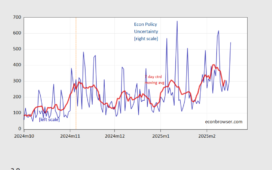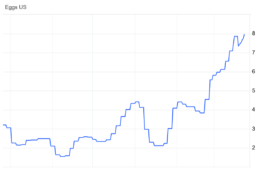Yves here. This article discusses the high odds of the so-called resource curse reappearing in the form of similarly sub-optimal exploitation of new essential minerals like lithium and cobalt. One has to wonder how much of the resource curse can be avoided. For instance, one could argue it is operates in the US but regionally. Look at how West Virginia, which has been exploited for coal, has become poor and polluted, or how area which have been heavily fracked have suffered contamination of aquifers, to the degree that tap water can be set alight.
By Rabah Arezki, Senior Fellow Foundation for studies and Research on International Development (FERDI); Director of Research French National Centre for Scientific Research (CNRS); Senior Fellow Harvard Kennedy School, and Frederick Van Der Ploeg, Professor of Economics University Of Oxford. Originally published at VoxEU
A race is raging among global powers to secure access to critical minerals to power the simultaneous energy and digital transitions the world is experiencing. The extraordinary growth in demand for critical minerals is putting upward pressure on prices and stimulating new critical mineral discoveries all around the world. However, in developing countries, this new bonanza presents opportunities but also important risks. This column argues that absent governance system shifts, the rush for critical minerals risks creating a ‘new curse of critical minerals’.
While both the energy and digital transitions rely on technologies that require critical minerals, it is the clean energy transition that is most prominently associated with the intensive use of these minerals. Technologies including wind turbines, solar PVs, electricity networks, electric vehicles and nuclear power require minerals such as copper, lithium, nickel, silicon, cobalt, rare earth elements and uranium. Demand for these minerals is expected to grow very quickly as the clean energy transition gathers pace.
In the face of this growth in demand, the limited supply of critical minerals is already putting upward pressure on their prices. The International Energy Agency (2021) forecasts that mineral demand for clean energy technologies will rise at least four-fold by 2040 to meet climate goals, with particularly high growth for minerals needed for electric vehicles. Graphite, nickel, lithium, and rare earth minerals are expected to witness explosive demand under the scenario of meeting climate goals. In this column, we argue that the bonanza from the exploitation in developing countries create both opportunities but also important risks, especially for developing countries (Arezki and van der Ploeg 2023).
The production of critical minerals is relatively scattered. Yet the salient issue is where the residual production of critical minerals net of domestic consumption (i.e. exports), especially of raw critical minerals, is concentrated. The production of critical minerals is highly prevalent in the major economic blocs – China, the US, and the EU. These blocs typically consume more of what they produce, hence making them dependent on exporters of raw critical minerals. Australia, Russia, Kazakhstan, Democratic Republic of Congo, Mozambique, Chile, South Africa, and Zimbabwe, as well as many others, are important exporters of raw critical minerals, and thus are courted by superpowers that strive to ensure secure supplies of such minerals.
The geography of mining versus the processing of critical minerals is very telling. China completely dominates the processing of copper, nickel, cobalt, rare earths, and lithium, but it only dominates in the production of rare earths. Chile and Peru dominate in the production of copper, Indonesia dominates in the production of nickel, DRC dominates in the production of cobalt, and Australia and Chile dominate in the production of lithium. It is mind-boggling that China is the dominant producer in the world economy of offshore wind, onshore wind, solar, and electrical vehicles and has 40-45% global shares in the production of fuel cell trucks, heat pumps, and electrolysers (Leruth et al. 2022).
Many developing countries, including Zimbabwe, attempt to maximise the value of their raw critical minerals by setting up cartels. Historically, in response to the unfair share they believed that they received from the exploitation of these critical minerals, developing countries have set up producer cartels, such as OPEC. While these cartels may get higher prices for these critical minerals and add revenue to government coffers, in practice advanced economies eventually find alternative suppliers (for example, non-OPEC producers) or develop alternative products (such as synthetic palm oil or shale oil). Moving up the value chain would be a better route, but that too has proven difficult. The risk of cartelisation is another source of concern for the major economic powers dependent on exports from developing countries. The uneven distribution of production of critical minerals is, however, likely to diffuse as elevated prices steer exploration investment efforts and eventually lead to more discoveries (Arezki and van der Ploeg 2019). A case in point is production of lithium, the price of which has fallen after fears of scarcity in the face of extraordinary demand growth.
The ramping up of mining activities around critical minerals will have severe environmental, health, and social consequences. Indeed, mining activities can cause irreversible damage to the environment and are also a significant source of emissions of greenhouse gases, undermining climate goals. Mining of critical minerals is intensive in the use of water and can also contaminate water, especially in places where standards and controls are weak. Moreover, in places where labour standards are weak, working conditions can be very harsh and child labour is also rampant. Such places include the Democratic Republic of Congo, yet the DRC has become the darling of the US and the EU, despite huge governance challenges, on account of it negotiating contracts away from China.
The risk of environmental damage is exacerbated by NIMBY (not in my backyard) politics of the industrialised countries which consume these critical minerals abundantly. There is ample room here for international corporations, especially those headquartered in industrialised countries, to step up their efforts and adhere to their home standards to avoid an environmental and health disaster in most vulnerable countries where these minerals are extracted. If not confronted, these environmental degradations will leave behind people in the developing countries where critical minerals are extracted.
The new geopolitical environment whereby developing countries become the centre of attention of the major powers is likely to slow down or reverse democratisation in many developing countries. That is because new ‘geopolitical rents’ for leaders aligning with superpowers are now back. That does not augure well for citizens and the prospects for improved economic governance in developing countries.
Leaders of countries like the Democratic Republic of Congo have been courted simultaneously by China and the US. This is despite the poor track record in terms of governance and human rights abuses. The bonanza from critical minerals is not necessarily good news, however. Developing countries have traditionally not managed the proceeds from the exploitation of their natural resources well. This has been at the expense of their citizenry. The new geopolitical environment may make things worse.
The track record of developing countries in managing their natural resources has indeed been subpar, so much so that the term ‘resource curse’ was coined to describe the paradox of countries rich in natural resources performing worse than countries that are resource-poor. The macro-institutional consequences of traditional resources offer lessons on what to avoid when managing booms in critical minerals. Moreover, regulation at the national level has often failed to address issues of over-exploitation of natural resources as well as displacement, environment degradation, and risk to biodiversity, which are often best managed by local communities. The work of the late Elinor Ostrom sheds important light on the design of self-organised user communities to achieve sustainability in the exploitation of natural resources, which can be salient for getting the governance of critical material booms right.
Various existing international initiatives have focused mainly on transparency, such as the Extractive Industry Transparency Initiative (EITI). The development of environmental, social, and corporate governance (ESG) norms has roots in the socially responsible investing movement that began in the 1970s. It is unclear whether and how the ESG norms could be enforced, considering their voluntary nature. One encouraging sign is that consumers in advanced economies appear to be changing their behaviour with regards to the environment. But investor behaviour, especially in developing countries, may not be so amenable to change. The challenge with all these international initiatives is the difficulty in translating them to the right context and fostering ownership, especially at the local and national levels.
To avert a new curse of critical minerals, developing and advanced economies need to build a new model of international governance that accounts for interdependencies related to peace and stability, global health, and environmental and climate issues in a world increasingly organised into blocs. If externalities are to be internalised, a new international mode of governance will effectively deliver technology transfers from advanced to developing economies to provide the tools to address the threat of climate change and meet climate goals, including by moving value chains of critical minerals. This international governance should also promote effective access to international capital markets through, for example, green, nature, or blue bonds instead of opaque resource-backed loans. Developing countries also need to shift their domestic governance to ensure that foreign direct investment delivers on local content, environmental protection, and jobs to address rising discontent in communities where mining or other extractive industries operate.
See original post for references













